After my recent post on 5 Best Canadian REITs, a few readers reached out and asked about Canadian REIT ETFs and what my thoughts are. If you are not comfortable with holding individual stocks or individual Canadian REITs, investing in Canadian REIT ETFs makes sense because ETFs can provide greater diversification.
Just like owning individual REITs, investing in REIT ETFs is a great way to diversify your real estate portfolio, regardless of whether you own rental properties or not. Furthermore, you also gain exposure to different types of properties that you may not be able to own otherwise.
So what are some Canadian REIT ETFs available to Canadian investors? What are the best Canadian REIT ETFs available to Canadians? Let’s find out.
What are REIT ETFs?
A REIT is a company that owns, manages, operates, or finances income-generating real estate properties. Like mutual funds, REITs pool capital from investors and use that capital to purchase or acquire properties under company ownership.
REITs typically have higher dividend yields than regular dividend paying stocks. Due to the business structure of REITs, anywhere from 80 to 95% of the income after expenses are passed directly to shareholders without being taxed at the corporate level.
REIT ETFs are funds that invest only in REIT stocks. Usually, each REIT ETF utilizes different strategies in picking the underlying REITs. For example, some follow a specific benchmark, some use an equal weight segment approach and some focus on a specific segment.
Best Canadian REIT ETFs
Since there are many different REIT ETFs, I decided to examine ones that focus on the Canadian market and trade on the TSX. Below are the 5 Best Canadian REIT ETFs.
1. BMO Equal Weight REITs Index ETF (ZRE.TO)
The BMO Equal Weight REITs Index ETF (ZRE) aims to replicate the performance of the Solactive Equal Weight Canada REIT Index, net of expenses.
As its name suggests, ZRE only invests in Canadian REITs and no Canadian stocks in the other sectors. Furthermore, the ETF deploys an equal weighting strategy for the 22 underlying holdings.
- Ticker: ZRE
- Number of holdings: 24
- Dividend Yield: 3.84%
- Distribution Frequency: Monthly
- Management Expense Ratio (MER): 0.61%
- Assets Under Management: $799.21 million
The top five holdings for ZRE are:
| Weight % | Name | Ticker |
| 4.51% | Slate Grocery REIT | SGR.UN |
| 4.48% | Chartwell Retirement | CSH.UN |
| 4.44% | Allie Properties REIT | AP.UN |
| 4.43% | Boardwalk REIT | BEI.U |
| 4.42% | Choices Properties REIT | CHP.UN |
Due to the equal weight nature of this ETF, the top five holdings only make up less than 30% of the overall ETF. This is very different from the other four REIT ETFs mentioned in this article. For investors looking for diversification across the Canadian REIT sector, the BMO Equal Weight REITs Index ETF may be a good ETF to consider.
If we look at the REIT segment/sector allocation, we’ll see that the fund does a pretty good job allocating across the different REIT sectors. The top two sectors are retail REITs and residential REITs.
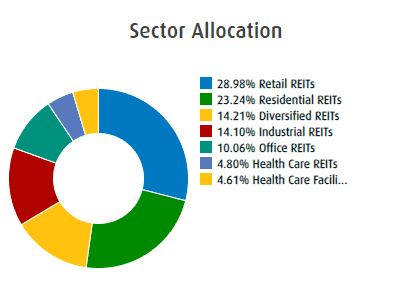
2. Purpose Real Estate Income ETF (PHR)
Purpose Real Estate Income ETF focuses on having a diversifying source of income and growth linked to a broad portfolio of high-quality real estate assets. The ETF has a strong focus on high-growth sub-sectors and avoidance on sunset industries. The fund managers try to select REITs with solid growth, strong balance sheet, low debt, and sustainable payout ratios.
- Ticker: PHR
- Number of holdings: 44
- Dividend Yield: 3.48%
- Distribution Frequency: Monthly
- Management Expense Ratio (MER): 0.80%
- Assets Under Management: $41.5 million
PHR is the smallest REIT ETF on this list. It is also the only REIT on the Best Canadian REIT ETFs list that has a large allocation outside of Canada at 38.94%. At 44 holdings, PHR also has the largest number of holdings compared to the other four Canadian REIT ETFs.
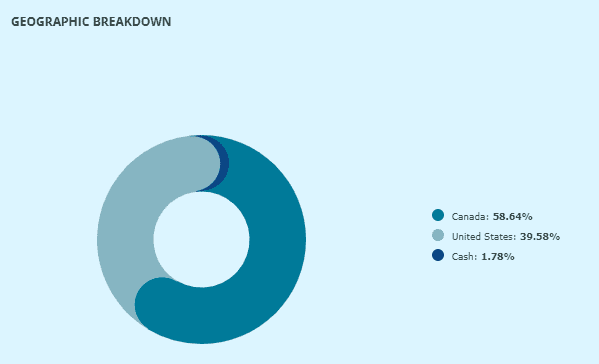
The top five holdings for PHR are:
| Weight % | Name | Ticker |
| 6.87% | BSR REIT | HOM.UN |
| 5.31% | Chartwell Retirement | CSH.UN |
| 4.89% | Flagship Communities REIT | MHC.U |
| 4.10% | Granite REIT | GRT.UN |
| 3.75% | Nexus Industrial REIT | NXR.UN |
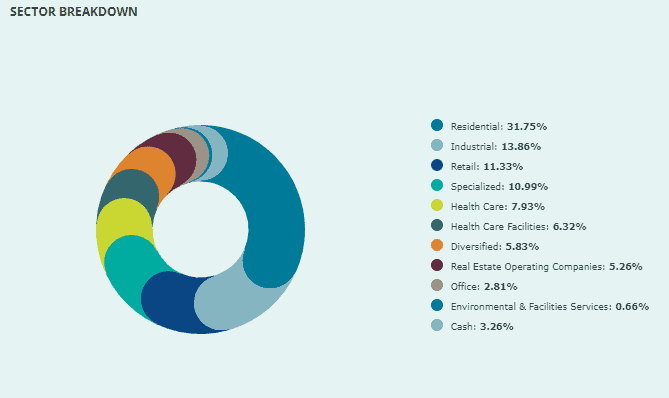
Residential REITs (31.75%) make up a large portion of PHR. Industrial REIT at 13.86% and retail REIT at 11.33 are respectively the second and third largest sectors of this ETF.
3. Vanguard FTSE Canadian Capped REIT Index ETF (VRE.TO)
Vanguard FTSE Canadian Capped REIT Index ETF seeks to track the performance of a broad Canadian real estate equity index that measures the investment return of publicly traded securities in the Canadian real estate sector. Currently, VRE seeks to track the FTSE Canada All Cap Real Estate Capped 25% Index.
- Ticker: VRE
- Number of holdings: 16
- Dividend Yield: 2.94%
- Distribution Frequency: Monthly
- Management Expense Ratio (MER): 0.38%
- Assets Under Management: $350.60 million
The top five holdings for VRE are:
| Weight % | Name | Ticker |
| 13.75% | Canadian Apartment REIT | CAR.UN |
| 11.97% | RioCan REIT | REI.UN |
| 10.24% | FirstService Corp | FSV.TO |
| 8.70% | Granite REIT | GRT.UN |
| 8.34% | Allied Properties REIT | AP.UN |
VRE only holds 16 REITs, so the top five holdings make up a large portion of the ETF. In fact, the top 5 holdings make up 53% of VRE and the top 10 holdings make up close to 85% of VRE. However, since VRE is capped, no individual REIT will make up more than 25% of the overall ETF weight.
When we examine the sector breakdown, VRE is comprised of 25.4% retail REITs, 18.6% Real Estate Services, 17.1% office REITs, 17% residential REITs, 8.9% diversified REITs, 8.7% industrial REITs, and 4.2% of real estate holding and development.
4. CI First Asset Canadian REIT ETF (RIT.TO)
CI First Asset Canadian REIT ETF seeks long-term total returns consisting of regular income and long-term capital appreciation from an actively managed portfolio comprised primarily of securities of Canadian REITs, real estate operating corporations and entities involved in real estate related services. Up to 30% of the Fund’s assets may be invested in foreign securities.
- Ticker: RIT
- Number of holdings: 36
- Dividend Yield: 3.91%
- Distribution Frequency: Monthly
- Management Expense Ratio (MER): 0.87%
- Assets Under Management: $750.64 million
The top five holdings for RIT are:
| Weight % | Name | Ticker |
| 5.25% | Summit Industrial REIT | SMU.UN |
| 5.21% | Tricon Residential Inc | TCN.TO |
| 5.18% | Dream Industrial REIT | DIR.UN |
| 5.09% | Granite REIT | GRT.UN |
| 4.19% | BSR REIT | HOM.UN |
The top five holdings comprise 24.92% of RIT and the top 15 holdings comprise 62.31% of the ETF. When we examine the top 15 holdings, RIT appears to be dominated by industrial REITs (15.5%) and residential REITs (41.56%).
Since RIT may have up to 30% of the assets invested in foreign securities, as of the time of writing, RIT has 8.45% of its assets allocated outside of Canada. For investors looking for REIT exposure outside of Canada, RIT may be a good choice.
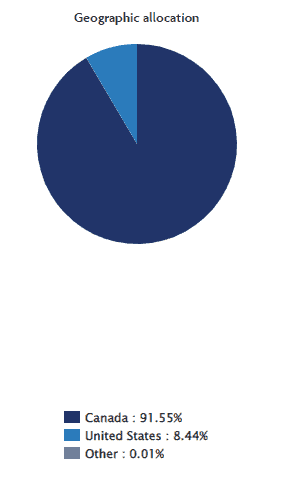
One key thing to point out is that RIT has a relatively high MER of 0.87%. This is because RIT is an actively managed ETF so there could be a lot of turnovers and changes from month to month.
iShares S&P/TSX Capped REIT Index ETF seeks to provide long-term capital growth by replicating the performance of the S&P/TSX Capped REIT Index, net of expenses. The ETF holds a total of 19 Canadian REITs.
- Ticker: XRE
- Number of holdings: 19
- Dividend Yield: 3.35%
- Distribution Frequency: Monthly
- Management Expense Ratio (MER): 0.61%
- Assets Under Management: $1,267.74 million
Out of all the Canadian REIT ETFs covered so far, XRE has the largest assets under management at over $1.34 billion. This shouldn’t come as a surprise since XRE is one of the oldest ETFs in Canada.
The top five holdings for XRE are:
| Weight % | Name | Ticker |
| 13.36% | Canadian Apartment REIT | CAR.UN |
| 11.29% | RioCan REIT | REI.UN |
| 8.9% | Granite REIT | GRT.UN |
| 8.63% | Allied Properties REIT | AP.UN |
| 6.09% | Choice Properties REIT | CHP.UN |
The top five holdings make up 48.27% of the ETF and the top ten holdings make up 76.11% of the ETF.
XRE is heavily exposed to retail, residential, and industrial REIT sectors. It also has a little over 10% exposure to the office REIT sector. I think having high exposure to retail and residential REIT sectors is fine, but investors will probably remember that the retail REIT sector performed poorly early on during the global pandemic.
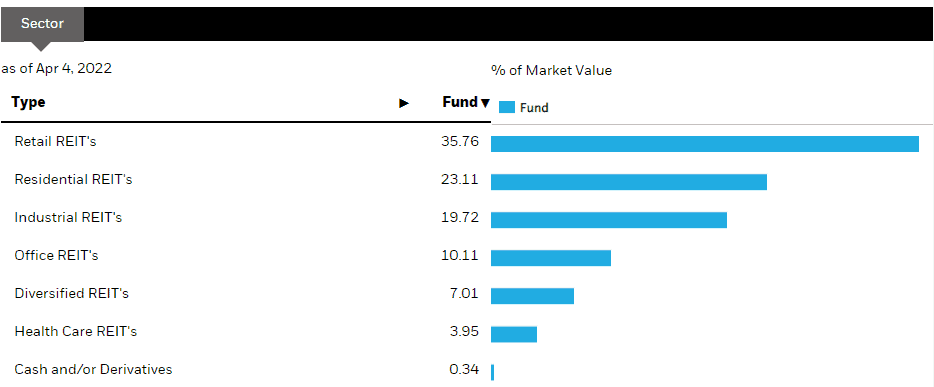
Comparing Best Canadian REIT ETFs
All five of these Canadian REIT ETFs have their strong points and weaknesses. Before we pick an overall winner, let’s take a closer comparison between all five of these ETFs.
Best Canadian REIT ETFs – Sector weighting
There are seven different REIT segments/sectors:
- Industrial
- Healthcare
- Hotel
- Office
- Retail
- Residential
- Diversified
Some REITs can own a mix of segments, for example, office, retail, residential, and healthcare properties, making them diversified REITs.
Since the five Canadian REIT ETFs all have different selection criteria, they have completely different sector weighting. One thing to note is that some of these ETFs invest in real estate services and real estate holding and development, so I included Service as one of the sectors. Another thing to note is that none of these Canadian REIT ETFs invest in the hotel REIT sector (that sector is very small in the Canadian REIT market), so I have excluded the hotel sector in the table below.
| Industrial | Healthcare | Office | Retail | Residential | Diversified | Services | |
| ZRE | 14.10% | 9.41% | 10.06% | 28.98% | 23.24% | 14.21% | 0% |
| VRE | 8.7% | 0% | 17.10% | 25.40% | 17.0% | 8.9% | 18.6% |
| RIT | 21.4% | 5.3% | 6.2% | 19.0% | 30.5% | 7.1% | 10.5% |
| PHR | 13.86% | 14.25% | 2.81% | 11.33% | 31.75% | 5.83% | 17.05% |
| XRE | 19.72% | 3.95% | 10.11% | 35.76% | 23.11% | 7.10% | 0.00% |
All of the REIT ETFs, except for VRE, have a relatively high allocation to the residential sector. Since we all need a roof over our heads, investing in residential REIT makes a lot of sense to me. RIT and PHR are two ETFs that have the lowest allocation to the office sector which can be a good strategy considering many workers, myself included, are still working from home. ZRE, VRE, and XRE all have a high allocation to the retail sector.
Best Canadian REIT ETFs – Yields, MER, # of holdings
Many investors are attracted to REITs because of the higher yields. Let’s compare the yields, the MER, and the number of holdings of these five Canadian REIT ETFs.
| Yield % | MER % | Holdings | |
| ZRE | 3.84% | 0.61% | 24 |
| VRE | 2.94% | 0.38% | 16 |
| RIT | 3.91% | 0.87% | 36 |
| PHR | 3.48% | 0.80% | 44 |
| XRE | 3.35% | 0.61% | 19 |
ZRE and RIT have the highest yields out of all five Canadian REIT ETFs but RIT has the highest MER fee of 0.87%. PHR offers the highest number of holdings and its yield and MER are both in the middle range compared to the other ETFs.
Interestingly, while VRE has the lowest fee, it also has the smallest number of holdings, and most importantly, the lowest yield.
Best Canadian REIT ETFs – Past Performance
Long time readers will know that we are total return investors – we value a steady dividend income but we also value asset appreciation. Therefore, it is important to look at the past performance of these five Canadian REIT ETFs.
| 1 Yr | 3 Yrs | 5 Yrs | 10 Yrs | |
| ZRE | 24.75% | 10.48% | 12.20% | 8.99% |
| VRE | 18.32% | 6.04% | 8.08% | n/a |
| RIT | 28.3% | 10.2% | 10.4% | 10.8% |
| PHR | 26.19% | 10.0% | 8.55% | n/a |
| XRE | 22.38% | 6.78% | 9.44% | 7.44% |
The one year performance is somewhat comparable between ZRE, RIT, and PHR with RIT leading the way at 28.3%. Given RIT is an actively managed REIT ETF, investors should expect a higher short term return, given the higher MER. The Canadian REIT sector suffered significantly early on from the global pandemic in mid to late 2020 but the sector has bounced back strongly in 2021 and so far this year. Having said that, it is interesting that VRE has the lowest one-year performance out of all five ETFs.
When we extend the performance comparison to five years, ZRE leads the way with a 12.2% return while VRE trails behind at 8.08%. Although RIT is an actively managed ETF, it only managed to outperform ZRE by 0.81% over a ten-year period. It does beg the question of whether an actively managed ETF is a good idea or not.
Best Canadian REIT ETF – Final Pick & Summary
Overall, I believe all five of these Canadian REIT ETFs provide excellent diversification within the Canadian REIT sector. If investors are looking for some geographical diversification, they might want to consider RIT and PHR. Between RIT and PHR I probably would pick PHR because of the lower MER.
Now, if I were to pick one Canadian REIT ETF to invest in, which one would I pick as the winner?
After looking at all the factors, I believe the BMO Equal Weight REIT Index, ZRE, is the best Canadian REIT ETF to invest in. It has a reasonable MER and one of the highest yields. On top of that, ZRE is one of the oldest REIT ETFs in Canada and has had a solid performance since its inception. The equal weight structure also means that you are not heavily exposed to one specific REIT. For investors looking for diversification within the Canadian REIT sector, ZRE is an excellent pick.
Looking for other comparisons? Check out the following articles.
- All-in-one ETFs comparison
- All-equity ETFs comparison
- Top Canadian dividend ETFs
- Top US dividend ETFs
- VXC vs. XAW. The battle of ex-Canada international ETFs
- The Best Preferred Share ETFs in Canada
- Best Canadian Bank ETFs
- Evermore Retirement ETFs
- Best Canadian renewable energy stocks
Dear readers, what do you think about my comparison of the best Canadian REIT ETFs? Do you invest in one of these REIT ETFs?


Considering the tax implications of holding REITS , would you recommend Horozon’s HCRE for taxable account?
Any particular reason you went with HCRE? Generaly speaking Horizons funds are usually quite taxed efficient. But this may not be true if you start dripping in your taxable account.
I went with HCRE as it does not pay any dividends so I don’t need to worry about taxes in my non registered account.
I don’t plan to drip it though I am not sure I know why the tax efficiency would be impacted if I were to DRIP it.
TawCan
What do youthink of Middlefield Real Estate Dividend ETF? MREL.TO.
Thanks
Don’t know too much about MREL but from a quick look, it appears the ETF is exposed not just to the Canadian market but US and international as well. It is weighed heavily in industrial, retail, and residential REIT sectors.
Another great post for a couch potato investor! 🙂
How do you feel about adding a column that shows the amount of the distributions that are considered ‘other income’?
Thank you. Sorry, what did you mean by another column showing the amount of distributions from other income?
I suspect I wasn’t very clear! What I meant was that % dividends (or distributions) is readily available. The taxation of those dividends varies widely based on the mix of eligible dividends, capital gains, return of capital and the highly taxed other income. Understanding the %allocation of each category, or a minimum, the weighting of ‘other income’ would be helpful.
Given ‘other income’ is taxed at the investor’s marginal rate, a lucrative dividend-rate can be misleading.
Ah, I see what you mean. Not sure if it’s easy to do that since the mix of eligible dividends, capital gains, return of capital, etc vary quite a bit year over year. For example, if you look at RIT’s tax factor breakdown, you’ll see it’s quite complicated.
https://funds.cifinancial.com/en/funds/ETFS/CICanadianREITETF.html?currencySelector=1&seriesId=14119
REITs return can’t beat rental properties without using leverage. That’s why I’m a landlord and also have in REITs in my TFSA.
That makes sense. 🙂
Great article Bob! thank you
I started holeding Reit in my portfolio about a year ago and so far so good , I was going to start with an ETF but then ended up with a couple of them so now I’m holding SRU NWH DIR CHP and my wife has CRT in her TFSA, I simply love the idea of having income from real estate without the headache of a tenant.
You’re welcome Gus. Happy investing.
Gus – you have a good start with some solid REITS. Good for you. NWH, SRU , CT, AX. Un Are some of my first ones . Bob started you off right I see . Tenants? Yuk! Fake rental histories , impossible to evict, impossible demands , nightmares . I use to own 6-7 homes . Not anymore- way too much work. While at University I saw a demand and bought my first wreck of a house . Developed 8 rental suites on it , parties every night, but it doubled in price over the 7 years at school and it paid for itself . That was the only success story as owner . Now I just use REITS OR PARTNERSHIPS , for exposure. The managers handle the late payments and other nonsense. Good luck to all …. Great blog Bob.
Thank you James,
wow 8 units ? that’s a lot to handle , I bought my first place at age 19 and I ended up with two rental units which i sold one last March and I’m hanging to the other one for now.
Can’t complain about real estate for me it was the first type of investing since I used to be scared of stocks in my early life 🙂
Yes Reit is the way to go sleep at night while collecting your monthly distributions
Gus , your on your way. In my portfolio they are ~18% . All in registered accounts. The tax treatment is not good in non registered accounts. Raw stock or sometimes preferred shares are the way to go . Good balance sheets, Div growth, debt in line with sector, Div payout ratio reasonable , P/ E ratio and other ratios reasonable … the key. Bob has the right idea for sure !
Great read , Thanks ! I personally just hold the individual REIT and mimic a solid profile of REITS (RIT is one ) ….bypassing the middle man . It has work for me for many years. By quality on sale , and you never look back . One area to keep in mind is Unit monthly P/O’s . They are taxed as “interest” in most non registered accounts – so not favourable , and the “Div” never increases for many of them . SO , be watchful over what account you have them in and if they ‘Share the wealth’ with their unit holders once a year or so . Especially important with hyper inflation coming . If I’m putting up their ‘ risk capital ‘ I like to get paid for it while I wait , at least to inflation plus a 1/2 % . Happy investing everyone ! James V .
Thanks. We hold individual REITs as well but some investors like the idea of further diversification by using an ETF.
Can you any comments on oil and gas ETF’s, or which ones you hold.
I really enjoy your comments/views on all things including the investments. A very common sense approach
Thank you
Eugene
I’m not familiar with oil and gas ETFs, will have to do some research and see about writing a post. Thank you.